
In 2024, the City of Toronto became the first municipality in Ontario to introduce comprehensive goat grazing for ecosystem management. Following the success of the 2024 pilot, the City of Toronto is bringing the goats back to Don Valley Brick Works Park in 2025 to graze a new section of meadow.
Urban managed meadows, such as the meadow at DVBW Park, contribute to the important habitat diversity and urban ecology of Toronto. Prescribed grazing represents an innovative integrative management tool for the City to help maintain the urban meadow ecosystem at DVBW.
Prescribed grazing is the practice of using livestock to address management concerns in habitats adapted to grazing, such as meadows and prairies. Prescribed grazing can address issues such as invasive, non-native or non-compatible plant species, woody vegetation encroachment and soil improvement.
Historically, grazing animals have shaped and maintained prairie and meadow ecosystems as they evolved together. For example, prairie ecosystems evolved over the past 30 million years along with over 20 large grazing species, including varieties of horses, rhinos, camels, mastodons, mammoths, antelope, deer and bison. Since the last ice age, only bison, antelope and deer families survived, with large herds of bison grazing throughout these ecosystems.
These large historical herds exerted pressure on the landscape and influenced the species that grew, along with the soil ecology. They brought nutrients to the soil through their wastes, reduced woody growth, and enhanced seed germination as their hooves disturbed the surface.
In modern times, land managers and researchers look to explore the use of grazing herds of domesticated livestock, such as goats, to mimic the actions of those ancient herds, preserving the health and diversity of meadow habitats.
Prescribed grazing has been shown to:
Maintaining many different healthy habitat types (habitat diversity) is important, particularly in urban areas under increased pressure. Different habitat types (forest, meadow, wetland etc.) all offer specific benefits, and are home to different plants and animals. Habitat diversity and health in urban natural areas is often sustained through ongoing, sometimes intensive, management activities.
To increase habitat diversity in Toronto, some areas of natural parkland are purposefully maintained as meadow habitat. Often somewhat rare in urban areas, meadows must be actively managed and maintained to remain viable habitat types. Many meadows are considered “sub-successional” habitat types, which means that if left alone they would become forests over time, as trees and shrubs would begin to take root.
Typically, within Toronto, meadow habitat that is unmanaged would progress to forest as woody species colonize the area, or might become overtaken with invasive species (such as Dog Strangling Vine, Buckthorn, or Garlic Mustard), losing both species diversity and habitat diversity.
Prescribed grazing is an additional management tool to help maintain these important meadow habitats. It can be integrated with many other forms of best management practices, including prescribed burning, herbicide application, and mechanical treatments (mowing/digging/pulling etc.), with each management practice having their own most effective niche, benefits and challenges.
Currently, urban meadows and prairies within Toronto are managed using a combination of techniques, such as herbicide application, mowing and burning. The Prescribed Grazing Project seeks to introduce grazing into the integrated management plan at Don Valley Brick Works Park, providing a new, environmentally friendly tool for meadow management, and an exciting opportunity to show the City’s commitment to innovative ecosystem management.
As an additional method in the City’s ecosystem management toolkit, prescribed grazing can offer several specific benefits for meadow management alongside other methods.
These may include:
The City is committed to ongoing monitoring initiatives to observe the Don Valley Brick Works meadow over time, to record how it responds to prescribed grazing activities.
Toronto Field Naturalists (TFN) is a volunteer-run non-profit with a desire to deepen understanding of, and appreciation for, the natural spaces and species needed for health and well-being. They are a member of the province-wide Ontario Nature network of naturalist organizations, and are a long time collaborator with the City of Toronto.
City of Toronto staff have been working with TFN to administer a volunteer monitoring protocol to observe species inventories in natural environment sites. This protocol has been employed successfully for several years at Cottonwood Flats, and was expanded and tailored to help monitor the meadow at Don Valley Brick Works Park and observe how it responds to grazing over time.
The goal of this partnership is to create and curate an inventory of flora and fauna biodiversity at DVBW prior to, and following, the introduction of prescribed grazing at the site, and will observe the site each year as grazing is ongoing. It will assess overall trends in vegetation, and examine whether the introduction of grazers produces a net positive impact on suppressing unwanted or invasive vegetation.
Photo monitoring involves taking a photograph from a permanently designated location, at different times of year, in order to observe changes in the botanical community over time and to document effectiveness of management techniques.
Photo monitoring plots are underway at Don Valley Brick Works Park, beginning with the pilot in 2024, and the sites will continue to be monitored before, during, and after the Prescribed Grazing Project by City staff.
Photos will be taken each year from plots in the last week of May, June, July, August, September and October.
Initial observations and monitoring data of prescribed grazing activities show early successes at Don Valley Brick Works Park.
It is important to recognize short-term observations that are apparent on site after one grazing session versus longer term observations that will take multiple years to monitor and observe.
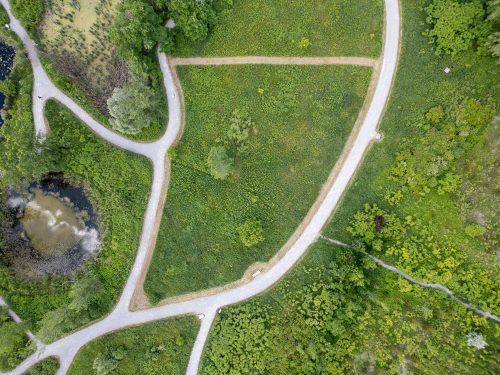
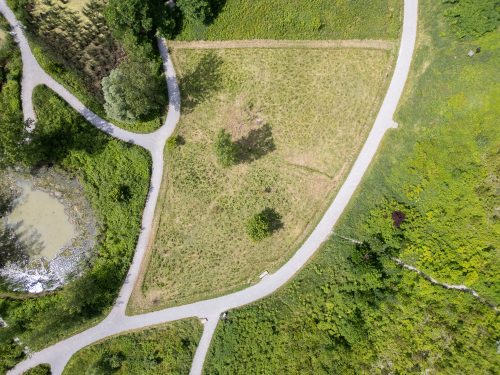
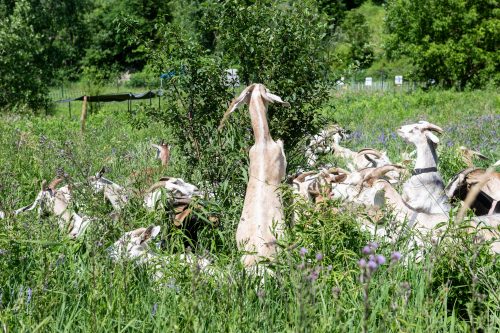
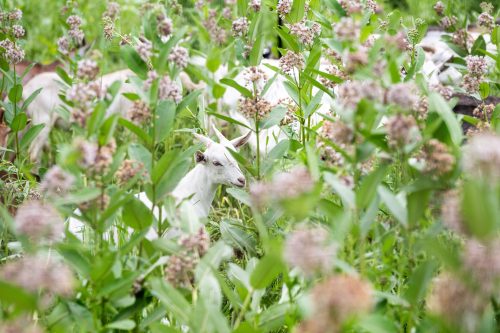
The City contracted Goats in the City Inc. as a preferred partner for the Prescribed Grazing Project. Based north of Toronto and founded with a vision to transform urban landscapes through sustainable practices, Goats in the City is specifically dedicated to utilizing their “eco-herd” of goats in urban and sub-urban prescribed grazing, with a specific interest in ecosystem management and sustainability. Their goats are not used for any other purposes than prescriptive grazing.
Goats in the City are part of an affiliated network of target grazing companies in North America who support each other through the transfer of knowledge and logistical support, with the collective of individual operators working together to improve and grow the industry. By leveraging collective expertise, this collaboration allows Goats in the City to stay at the forefront of best practices and innovative solutions in urban conservation. They bring a wealth of experience and knowledge to urban grazing initiatives, from project managers to animal handlers who have a commitment to sustainability, biodiversity conservation, and community engagement.
The Goats in the City eco-herd are chosen and bred to provide maximum effectiveness in prescribed grazing. They choose a large breed – Kiko Goats – to maximize the amount of vegetation the animal can consume. Goats eat between 3 to 4 per cent of their body weight every day. At the average weight of 70 kilograms, each goat consumes approximately 3 kilograms of vegetation daily, taking 60 goats approximately three days to consume one acre of vegetation. The size of their goats also allows them to tackle taller plants and unwanted woody vegetation, such as Buckthorn, up to 1.5 metres above ground.
During prescribed grazing, the safety and welfare of the goats is of the utmost importance. Safety considerations and site management have been considered at length in cooperation with Goats in the City and the City of Toronto.
The Goats in the City eco-herd are used strictly for prescribed grazing and are not sold or used for food. The goats will live out their full lives at the farm (other than grazing locations) and do not provide meat, milk or other consumable products. Grazing in a herd is natural behaviour for the goats.
The City will utilize proven safety strategies for both the public and animals, including double fencing, 24-hour in-person care and supervision, GPS herd tracking and on-call veterinarians. The eco-herd will remain in a secure enclosure, providing protection from predators and the public, with free access to water, sun and rain shelter.
Water will be delivered to the site and will be installed within the goat grazing area, where it will remain for the length of the project. Goats will always have access to water.
Goats tend to rest in the shade during the hottest hours of the day – between noon and 3 p.m. A temporary shelter will be set up for them for protection from sun and/or rain. The goats will always have access to this shelter.
Secure double perimeter fencing will be provided around the full project site. This fencing will keep the goats safe from any possible predators, and the public a safe distance from the goats while they work.
The exterior fence will be a tall metal mesh fence. For the interior fence, Goats in the City utilize mild low-voltage mesh fencing to help the goats visually understand the specific areas they are meant to graze. This fencing is also used as a deterrent to coyotes and other predators that may be present at the grazing site and is particularly useful overnight.
Two metre tall “Fast Fence” connectable panels will ring the outside of the grazing area next to park trails.
Portable fencing will also divide the grazing area to intensify stocking rates on each day. It will be moved to open new areas as the goats progress in their grazing.
There will be constant oversight of the goats during their time grazing, and the goats will never be left unsupervised. During the day, both Goats in the City and City of Toronto Forestry staff will be on site.
Overnight, Goats in the City staff will remain on site in a mobile command centre trailer and will continually monitor the herd. Emergency plans and measures are in place. Leaders in the goat herd are fitted with GPS and drone tracking technology that provides Goats in the City with real time alerts in the unlikely event any animals breach the boundary of the fencing. City of Toronto enforcement officers will also be on-call or on-site to support.
The City of Toronto will be implementing the Prescribed Grazing Project at Don Valley Brick Works Park (DVBW) from June 10 to 11, 2025.
Public hours to view the goats are from June 10 to June 11 between 10 a.m. and 6 p.m. Various opportunities to learn about the project will be available:
Check in at the Info Tent to sign up for any of the talks. *Talks may be limited depending on group size.
While we aim to provide fully accessible content, there is no text alternative available for some of the content on this site. If you require alternate formats or need assistance understanding our maps, drawings or any other content, please contact Cheryl Post at 416-392-1948.
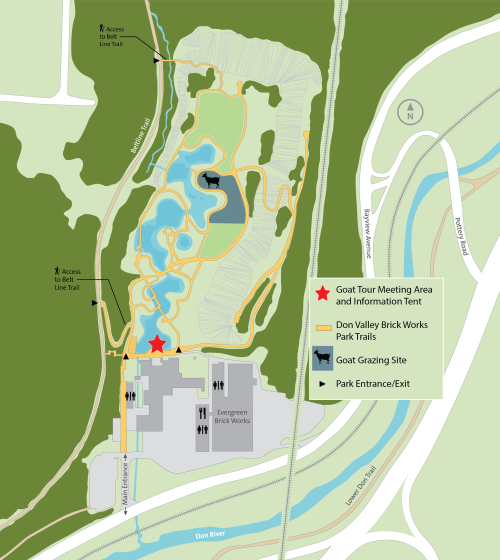
During grazing:
To ensure the safety of parks visitors and the animals, please follow all directions provided by City of Toronto and/or Goats In The City staff while visiting.
Don Valley Brick Works Park is located directly behind the Evergreen Brick Works buildings at 550 Bayview Ave.
Paid parking on-site is available at Evergreen Brick Work. Parking may be limited and is not managed by the City of Toronto.
Parking is also available nearby at Todmorden Mills.
Don Valley Brick Works Park connects to many trail networks including the Bayview Multi-Use Trail and the Belt Line Trail. The Lower Don Trail is also nearby, connecting to Bayview Avenue via Pottery Road.
Check out the City of Toronto’s Cycling Network Map
The Toronto Transit Commission (TTC) offers bus service to take you to Don Valley Brick Works Park.